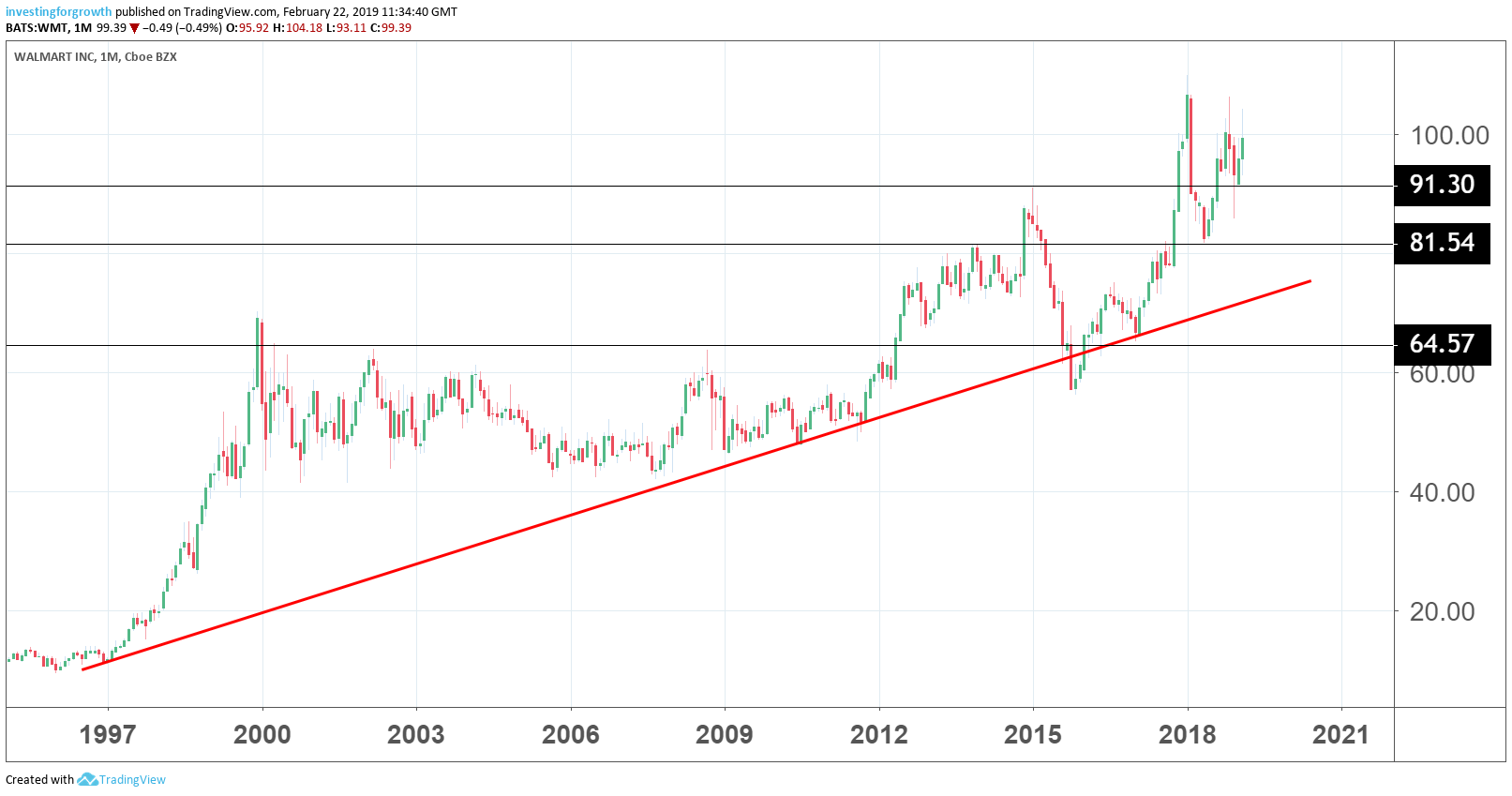Stockwatch: A buy for low-risk equity portfolios
This resilient stock has done well since Warren Buffett sold out, and strong figures make it one to own.
22nd February 2019 09:37
by Edmond Jackson from interactive investor
This resilient stock has done well since Warren Buffett sold out, and strong figures make it one to own.

This resilient stock has done well since Warren Buffett sold out, and strong figures make it one to own.
Does this $290 billion multinational retailer's recent performance imply capability to buck weaker consumer spending? And can its digital prowess underwrite a record of annual dividend growth since 1974?
Total fourth-quarter 2018 sales for Walmart (NYSE:WMT) grew 1.9% to $138.8 billion, pretty much in line with consensus and with the US representing about two-thirds of group sales. US growth is Walmart's strongest in nine years as e-commerce sales surged 43%, with grocery store pick-up and home delivery services being extended nationally, and greater product availability on Walmart.com after various clothing brand acquisitions.
Resilient performance despite volatile consumer confidence
Overall US retail sales fell by 1.7% in December, the most in 20 years and a shudder given the US is a relatively domestic-driven economy where consumer spending is the key. Possibly this influenced the Federal Reserve to soften its stance on monetary policy early last January, which many analysts credit being a chief reason for US stocks soaring - also markets globally.
Encouragingly, one of the most-watched indicators of US consumer sentiment – the University of Michigan index – has recovered in February to 95.5 after dropping from about 98 through October to December, to 91.2 in January. This takes consumer confidence levels from the second lowest since 2016, back up to those seen in mid-2018, with more respondents willing to buy a major household item or vehicle or house. Analysts conclude that personal consumption spending will remain the strongest element of the US economy this year.
An end to the US government shutdown and lower gas prices will have helped, also a general context of low unemployment and rising wages. Moreover, Congress has now passed legislation to avoid another shutdown.
Without a lot more negativity from consumer demand, all this should defer the risk of a US recession. Walmart is an important bellwether too. For equity investors, generally it's lucky how the Fed turned dovish shortly before these more encouraging signs of consumer resilience have appeared, hence a double-whammy effect to justify the 2019 equities rally as more than a "snapback in a bear market".
Now the third-largest online retailer in the US
Last November, Walmart overtook Apple (NASDAQ:AAPL), and though still behind eBay and Amazon (NASDAQ:AMZN) it continues to take share. In 2017 for example, Walmart began contesting Amazon's Prime (subscription) service with free, two-day deliveries on orders of $35 or more, and expanded this last year. For the long run it implies a traditional retailer's format, its sourcing/warehousing and e-marketing skills can work very well together, like Walmart's recent initiative to stock more toys after the demise of Toys R Us, which paid off last Christmas.
More online options are being introduced such as Lord & Taylor designer wear, 3D shopping, a sports-fan focused Fanatics shop, a Nursery destination and Walmart eBooks in partnership with Kobo.
Groceries are the priority, a new website making it easier to order and re-order favourite items. Some 90% of the US population lives within 10 miles of a Walmart store, hence the US equivalent of "click-and-collect" is being advanced. I recall drawing attention to this regarding Argos stores in the UK a few years ago, quite novel at the time and which really helped their turnaround.
Walmart's offering is "kerb-side" collection as a cheaper alternative to home delivery. It appears to believe this is a way forward as it extends the service from 2,100 to 3,100 stores by end-2020, relative to a US estate of around 4,700. Home deliveries are planned to rise from about 800 to 1,600 stores with the help of new partners. In relative contrast to online-driven growth, only 10 new stores are expected to open this year.
| Walmart Inc. | ||||||
|---|---|---|---|---|---|---|
| summary income statement to 31 Jan 2019 | ||||||
| Q4 | Yr-on-yr | Change | Year to | Yr-on-yr | Change | |
| $ | $ | % | 31-Jan-19 | $ | % | |
| Total revenue | 138,793 | 2,526 | 1.9 | 514,405 | 14,062 | 2.8 |
| at constant currency | 140,485 | 4,218 | 3.1 | 515,107 | 14,764 | 3.0 |
| Net sales | 137,743 | 2,583 | 1.9 | 510,329 | 14,568 | 2.9 |
| at constant currency | 139,423 | 4,273 | 3.2 | 511,037 | 15,276 | 3.1 |
| Membership income | 1,050 | -67 | -6.0 | 4,076 | -506 | -11.0 |
| Operating income | 6,067 | 1,600 | 35.8 | 21,957 | 1,520 | 7.4 |
| at constant currency | 6,159 | 1,692 | 37.9 | 21,959 | 1,522 | 7.4 |
| Interest charge, net | 605 | 106 | 21.2 | 2,129 | -49 | -2.2 |
| Other gains/losses | -202 | -202 | 0 | 8,368 | 8,368 | 0 |
| Consolidated income | 3,687 | 1,512 | 69.5 | 6,670 | -3,192 | -32.4 |
| EPS | 1.27 | 0.54 | 74.0 | 2.26 | -1.02 | -31.1 |
| Adjusted EPS | 1.41 | 0.08 | 6.0 | 4.91 | 0.49 | 11.1 |
Reflected in stock market valuation
In marketing terms then, Walmart is a success story with further potential in the US and increasingly in Canada and overseas. This kind of strong consumer franchise, mainly in essential than discretionary goods, helps explain why, just below $100 currently, its stock trades on a multiple of 20.4 times normalised earnings per share (EPS) of $4.91 for 2018.
This compares with 11% underlying earnings growth (a slight beat on consensus), hence a premium in respect of Walmart's durable consumer franchise, giving a sense this company can prosper despite risks with the US economy.
What extent, if at all, should a disciplined investor pay for "qualitative" strengths above what the raw numbers imply, at the risk of double-counting?
A modest 2.1% yield doesn't ease that concern, relative to yields around 5% or more on various big cap stocks listed in London, as if initially it seems Wall Street remains willing to engage bubble valuations. Yet Walmart's premium follows from a very long history of defensive growth: since the early 1970's its stock has enjoyed two major re-ratings, first in the late 1990s to 2000, then from mid-2015 coinciding with the company's push into digital marketing.

Source: TradingView, monthly chart (*) Past performance is not a guide to future performance
There have been very few down-dips - the biggest by a third in the first half of 2015 - as if patient holders of Walmart cannot go wrong, hence you can expect the stock to be priced for only modest yield.
To assert a medium-term bearish view of Walmart implies belief that global assets are due a major de-rating, which a few conservative monetarists do still warn (albeit have since 2010). Thus, Walmart is likely to remain on 'buy' lists for low-risk equity savings portfolios as a building block for pension funds etc.
Better all-round than key UK grocers
At 233p, Sainsbury (LSE:SBRY) shares yield just over 5% and is about 4 times covered by earnings, on a forward price/earnings (PE) around 12 times; Morrison (LSE:MRW) at 228p yields 4.4% about 1.6 times covered, on a forward PE of around 17 times; while perennial recovery situation Marks & Spencer (LSE:MKS) yields 6.5% covered 1.3 times, after a three-year downturn in market price, on a forward PE of 11.5.
Marks is a particularly good example why Walmart justifies a premium rating, hence lower yield; Marks' five-year record shows a major challenge to grind revenues higher, profits/earnings being volatile and cash flow per share in historic decline.
After rebounding in 2016, Morrison shares are in a volatile-sideways range and, though yielding over twice Walmart, it does not have the same extent of consumer marketing scope as Walmart, also Morrison's operating margin has been in decline below 2% in the tussle versus Aldi & Lidl. Sainsbury's is obviously in the news for current challenges, with the competition watchdog giving a damning report on its proposed merger with Asda.
So, while on initial comparison, major British grocers offer at least twice Walmart's yield, their stocks are arguably worse in terms of premium to earning power. Sainsbury's now trades at a near 20% discount to net tangible assets, however, Morrison is at a near 30% premium so, with the exception of Marks on a 101% premium, you could say these UK stocks are buttressed.
And the conclusion for the investment stance? If asked to pick one of these only, for the long term it's Walmart for its track record and marketing ability in the robust US economy, growing internationally too.
Though I am wary of US stocks being at historically high levels, 'hold' makes no sense for anyone reading with fresh money. 'Buy on weakness' understates Walmart, however, compared with AIM-listed Angling Direct (LSE:ANG) I wrote about last Tuesday, which has yet to prove a durable consumer franchise. Accumulate.
*Horizontal lines on charts represent levels of previous technical support and resistance. Trendlines are marked in red.
Edmond Jackson is a freelance contributor and not a direct employee of interactive investor.
These articles are provided for information purposes only. Occasionally, an opinion about whether to buy or sell a specific investment may be provided by third parties. The content is not intended to be a personal recommendation to buy or sell any financial instrument or product, or to adopt any investment strategy as it is not provided based on an assessment of your investing knowledge and experience, your financial situation or your investment objectives. The value of your investments, and the income derived from them, may go down as well as up. You may not get back all the money that you invest. The investments referred to in this article may not be suitable for all investors, and if in doubt, an investor should seek advice from a qualified investment adviser.
Full performance can be found on the company or index summary page on the interactive investor website. Simply click on the company's or index name highlighted in the article.
Disclosure
We use a combination of fundamental and technical analysis in forming our view as to the valuation and prospects of an investment. Where relevant we have set out those particular matters we think are important in the above article, but further detail can be found here.
Please note that our article on this investment should not be considered to be a regular publication.
Details of all recommendations issued by ii during the previous 12-month period can be found here.
ii adheres to a strict code of conduct. Contributors may hold shares or have other interests in companies included in these portfolios, which could create a conflict of interests. Contributors intending to write about any financial instruments in which they have an interest are required to disclose such interest to ii and in the article itself. ii will at all times consider whether such interest impairs the objectivity of the recommendation.
In addition, individuals involved in the production of investment articles are subject to a personal account dealing restriction, which prevents them from placing a transaction in the specified instrument(s) for a period before and for five working days after such publication. This is to avoid personal interests conflicting with the interests of the recipients of those investment articles.